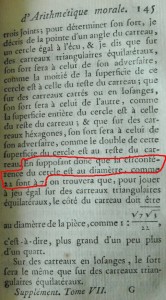I already mentioned Buffon’s needle a long time ago, with a picture of the page of my grandfather’s own copy of the multi-volume Histoire naturelle. Recently, I had a closer look at what Buffon actually wrote, and realized that, far from dropping unit-lengths needles to compute π, he was suggesting dropping well-calibrated needles to compute 1/2, or more precisely to create a fair game between two players, one of which bets on whether a needle dropped by the other will cross the boundaries of the strips of wood on the floor?
In fact, since he uses the “value” π=22/7 just a few pages before,
one can see that computing π must have been very far from his mind. The question thus arises: who did first interpret Buffon’s question as one that may lead to an estimate for π?
Equally recently, I noticed the following variant of the problem, which may already be known: suppose a player is allowed to throw a dart randomly anywhere on the complex upper half-plane (this may seem too “infinite”, but the disc model of the hyperbolic plane will work just as well if you want to throw darts to a circular target…), but that the dart is instantaneously moved, as soon as it touches the target, to the corresponding point of the fundamental domain of
(in principle, this is an operation that can be performed very efficiently by some variant of the euclidean algorithm, though in practice there are numerical stability problems for points very close to the boundary of the fundamental domain). Now the bet with the other player is whether the point in the fundamental domain will have imaginary part larger than some fixed a>0.
As Buffon, we ask: which value of a will ensure that this is a fair game? If we assume that the point in the fundamental domain is uniformly distributed for its probability Poincaré measure, which is , it is easy to see that the answer is
, so we have some kind of hyperbolic Buffon needle. To make this into a “computing π procedure”, one may for instance “throw darts” successively at the points
on the segment of horocycle at height , for some large
, and look at the corresponding points
in the fundamental domain. Then it is is a well-known result (which follows here most easily from non-trivial bounds on Hecke eigenvalues of Maass cusp forms) that as
grows, the points
become equidistributed in the fundamental domain for the Poincaré measure, and hence that the proportion among them which have imaginary part larger than
converges to
. Hence if we look at the median of this sequence of imaginary parts, we will find that it converges to
as
tends to infinity…

